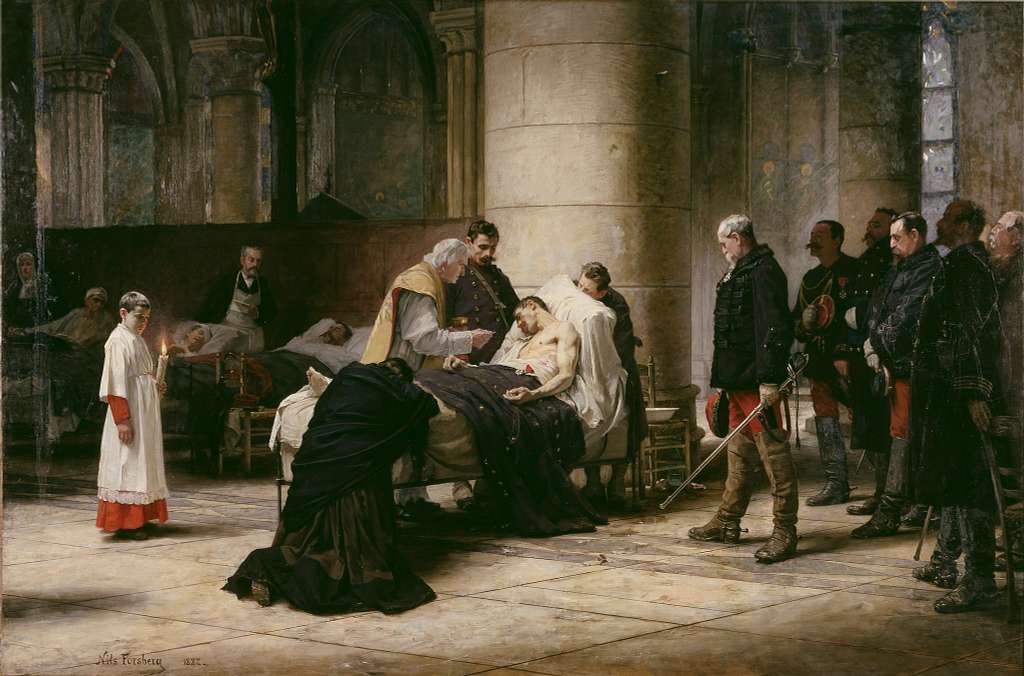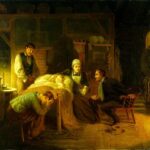William Shakespeare thought his family was safe from the plague. His eldest, Susanna, and the twins, Judith and Hamnet, were with their mother in Stratford-upon-Avon in Warwickshire.
Stratford was a prosperous market town some eighty miles from London, a journey of two or three days on horseback along the convoluted byways of Elizabethan England, including a stop for the night in Oxford. Stratford’s central location between Wales, London, and the north made it a crossroads for commerce and culture. It also had something the capital did not: an abundance of trees, lush foliage, and a peaceful rural setting.
Shakespeare’s children seldom if ever visited London. Their education didn’t suffer—schooling was free and widespread for the middling ranks of society in Stratford. In 1594 Shakespeare had co-founded a successful acting company, the Lord Chamberlain’s Men. His family was planning to purchase a large house and was eagerly anticipating the College of Heralds award of arms in autumn of 1596. It seemed that their future was assured.
But disease plays no favorites.
When Shakespeare was an infant, a pandemic ravaged the capital in 1563. The following year it killed 200 of Stratford’s 1,800 inhabitants, including four children of the miller Roger Green’s family, who lived a few doors down from the Shakespeares. The epidemic passed only to return in 1592-3. It claimed nearly 11,000 lives of the 125,000 London inhabitants, closing theaters in London and stubbornly lingering outside the capital.
In 1596 the provinces suffered their greatest mortality, among them Shakespeare’s eleven-year-old son, Hamnet. The younger twin had always been prone to sickness. He fell ill in early August 1596 and died within days. Shakespeare would never be the same.
Loss must inevitably find expression, all the more for creative artists. Shakespeare was no different. His future plays were steeped in grief. “Give sorrow words,” he wrote in Macbeth ten years after his son’s death. “The grief that does not speak whispers the o’erfraught heart and bids it break.”
Shakespeare never shied away from tough questions nor did he offer easy answers. He spoke to the worst and best of life, exploring themes of spirituality and meaning, loss and resurrection, twin figures, paternal guilt, father-daughter relations, family strife and reunion. With prescient insight, Shakespeare threw light on many aspects of.
Kenneth Heaton, Reader in Medicine at the University of Bristol for three decades, examined Shakespeare’s work for evidence of physical manifestations of grief. Heaton looked at 39 plays and 3 long narrative poems, finding 140 instances of 31 different grief-associated symptoms. “Shakespeare’s empathy with grieving humanity was unrivalled,” Heaton concludes.
Shadow Grief
Shakespeare was no stranger to sorrow. His parents lost two children before he was born. Shakespeare’s younger sister, Anne, died at the age of seven in 1579. He was to see his parents and four younger siblings pass: at the time of the playwright’s death in 1616, only his sister Joan survived.
Then as now, the death of a younger sibling receives scant social acknowledgement despite having marked similarities to losing a child. It casts a long shadow, as in Richard II, which uses the word grief more than any of his other works. Shakespeare wrote Richard II in 1595, two years after the epidemic had cost the lives of many Londoners and remained an active fear in the provinces.
The play is set in the fourteenth century. The Black Death has weakened the foundations of the Plantagenet monarchy. Richard inherited a throne surrounded by death. His consolers offer the usual glib solutions to mourning: time, logic, resolve, distraction. But none satisfies. The play suggests that sorrow does not end: it must be endured, faced, and accepted. Grief is a teacher and a constant companion. “The shadow of your sorrow,” observes Bolingbroke, “hath destroyed the shadow of your face,” to which Richard replies:
Say that again:
‘The shadow of my sorrow’ –ha, let’s see. ‘Tis very true: my grief lies all within, And these external manners of laments Are merely shadows to the unseen grief That swells with silence in the tortured soul.
Modern experts have identified the pattern Shakespeare described. “Shadow grief,” as they call it, is not overt nor is it debilitating. The bereaved continue in a more or less normal life. But their sorrow is never completely resolved nor can it be. It will always be part of their new existence, an “unseen grief that swells with silence.”
By the sixteenth century societal constrains regarding what to do and say when faced with death had become particularly vexing. The bereaved were offered traditional platitudes: it is God’s will, he is at peace, and so on. These well-meant expressions of sympathy do little to ease the devastation of losing a child, as Shakespeare was aware. “Everyone can master a grief but he that has it,” he wrote in Much Ado About Nothing, two years after Hamnet’s death.
Others expected Shakespeare to refrain from overt expressions of sorrow, or at least to mourn in quiet and within a suitable time frame. But Shakespeare’s grief found its way into his plays for the rest of his career.
“I shall see my boy again”
When Hamnet died, Shakespeare had been working on King John. What started as a desultory historical epic, filled with the same jingoism as Richard II, was after Hamnet’s death transformed by some of the poet’s most poignant verse. John’s role is small, nearly unimportant. Political conflicts between good and evil are replaced with introspection. “I’ll go with thee,” declared a character who echoed Shakespeare’s grief, “and find th’inheritance of this poor child, his little kingdom of a forcèd grave.”
King John is a human play. In it, Cardinal Pandolf reprimands Constance for her displays of mourning: “You hold too heinous a respect of grief.” Constance lashes out at his pious judgment, “He talks to me that never had a son.” King Phìlippe chimes in on the same note, “You are as fond of grief, as of your child.” Constance replies:
Grief fills the room up of my absent child, Lies in his bed, walks up and down with me, Puts on his pretty looks, repeats his words, Remembers me of all his gracious parts, Stuffs out his vacant garments with his form. Then have I reason to be fond of grief.... O Lord, my boy, my Arthur, my fair son, My life, my joy, my food, my all the world, My widow-comfort, and my sorrows' cure!
This scene eloquently details acute grief—the overwhelming burden of sorrow that is often accompanied by a sense that the lost loved one is present. Shakespeare may well have felt the same. “I have heard you say that we shall see and know our friends in heaven,” Constance tells Cardinal Pandolf. “If that be true, I shall see my boy again.”
Time to Mourn
Shakespeare gave himself time to grieve his son, whether by choice or necessity. He completed the wildly successful The First Part of Henry the Fourth shortly after Hamnet’s passing. Then his output was considerably diminished. He wrote only three plays between 1596 and 1598.
The Merry Wives of Windsor, begun within a few months after Hamnet’s death in early 1597, is a comedy that has little to recommend it. Many of the elements for engrossing theater are there, but they do not combine well: the result is dull and lifeless. However, Giuseppe Verdi spotted hidden gems in the play. Himself a bereaved parent, Verdi often took inspiration from Shakespeare’s work. His operatic version of The Merry Wives of Windsor shears away Shakespeare’s uncharacteristic dross to deliver the masterpiece, Falstaff.
Shakespeare also wrote the second part of Henry the Fourth in 1597 and followed it the next year with the brilliant comedy, Much Ado about Nothing. This timeline is not surprising. It usually takes three-to-five years to put a death in perspective, often longer for bereaved parents. The first two years can be excruciating; it is remarkable that Shakespeare wrote anything at all.
The death of an only child (or a sole heir, as with Hamnet), carries a dual loss: whatever future the parent envisioned with grandchildren and the family name is now gone forever. This reaction was part of Shakespeare’s mourning. Hamnet would have inherited the large house and estate, the family coat of arms, and the Shakespeare sword. The playwright’s work from this period is preoccupied with father-son relationships: the flawed older man’s frustrated attempts to communicate what he has learned about life, the future, and the inevitability of time.
The sonnets also reveal a number of allusions to Hamnet. This is not surprising: Shakespeare started work on them in 1593 when London theaters closed in the face of epidemic. He finally finished the sonnets in 1600, four years after his child’s death, but did not publish until 1609, preferring instead to share them with friends.
The sonnets speak of the cruel destructions of time and how the youth addressed in the poems is immortalized in verse. In this light, discussions in the early sonnets of marriage and the possibility of future generations are especially poignant. Sonnets 55, 60, 65 and 68 were probably influenced by Hamnet’s death. Of them all, however, 33 is most clearly a lament. As one scholar observed, the metaphor of “sun” for “son” identifies the addressee as Hamnet.
...my sun one early morn did shine, With all triumphant splendour on my brow; But out, alack, he was but one hour mine; The region cloud hath masked him from me now. Yet him for this, my love no whit disdaineth: Suns of the world may stain, when heaven's sun staineth.
Spiritual Crisis
Following the death of Hamnet, Shakespeare experienced a spiritual crisis. This revealed itself in many aspects of Shakespeare’s work, most tellingly in Hamlet, which he wrote in 1600. Both Richard II and Hamlet deal with self-absorbed men. The characters are melancholic and grieving, but where Richard revels in wit, Hamlet is faced with a believably real quandary: To be or not to be is more than an exercise in clever linguistics.
Hamlet also offers profound insight into the complex nature of masculine mourning. The obvious similarity of the names Hamlet and Hamnet aside, the play itself is preoccupied with twinning: the act of sublimation; doubling themes; the use of two points to describe a single complex meaning; a play within a play; all are delivered in a masterpiece of lyricism. The title character displays much of the terrifying anxiety and exhausting nature of grief while examining internal struggles that lead ultimately to transformation.
Hamlet’s first soliloquy reveals his growing despair over the death of his father and his mother’s remarriage. He has not yet heard the Ghost’s story. It is the first hint that he is considering ending his life:
O God, God, How weary, stale, flat, and unprofitable Seem to me all the uses of this world!
Near the end of the play, Hamlet has learned to live with his heartbreak. He throws himself into dangerous situations but not in self-punishment. Rather, Hamlet is unconcerned. Shakespeare had a similar experience.
Friends of bereaved parents often despair that the grieving appear to have given up when actually the opposite is true. Many parents say they have come to appreciate life in ways they did not before, now cherishing its preciousness and transience. Shakespeare expressed this awareness in the 1599 play, As You Like It, when the just and carefree character Duke Senior “finds tongues in trees, books in the running brooks, sermons in stones, and good in every thing.” Time spent in nature can indeed offer profound solace to the grieving, but Shakespeare did not ignore the daily realities of living with loss.
Through Hamlet the playwright acknowledged the terrible vulnerability of our existence. Having faced the worst that life can offer, he had lost his fear of the future and of death:
There’s a divinity that shapes our ends, rough hew them how we will. . . . There is special providence in the fall of a sparrow. If it be, ’tis not to come. If it be not to come, it will be now. If it be not now, yet it will come. The readiness is all. Since no man of aught he leaves knows, what is’t to leave betimes? Let be.
Shortly after Hamlet was finished, in 1601, Shakespeare’s father died. Shakespeare began work on All’s Well That Ends Well, finishing sometime between 1603 and 1605. This is one of the poet’s notorious “problem plays”: an experiment in genre that blends dark themes and anguish with comic elements and unsettling endings.
The story surprises us with its compassionate view of a somewhat unsavory Bertram. It is also the only play in which Shakespeare opens with a speech by an ordinary woman: a mother and a widow. The opening scene sets the tone of loss that will be an undercurrent throughout the play. Bertram is taking his leave:
COUNTESS In delivering my son from me, I bury a second husband. BERTRAM And I in going, madam weep o'er my father's death anew
As always with Shakespeare’s comedies, the plot is too convoluted to adequately describe here (or anywhere, for that matter). Suffice to say that amid the laughs there is an underlying theme that binds together grief and loss. The play is a creative meditation on death and renewal.
Grief often leads to a quest for meaning and new discoveries of what that entails. Crystal Park, a respected clinician whose research focuses primarily on bereavement and spirituality, has found that the bereaved must inevitably give some significance to the belief that their loved ones go on. Shakespeare was no exception. He was to return again and again to themes of belief, suffering, and reunion.
A Father’s Regret
Shakespeare’s career kept him away from his family, that much is certain, but that does not signify a lack of affection for his son. Love is not measured by time spent with a child, nor is grief measured by time spent without a child. Modern research has confirmed that parental bonds are usually immediate, persistent, and absolute.
Fifteen years after Hamnet’s death, Shakespeare described in The Winter’s Tale how the mere mention of a name still had the power to wound:
Prithee no more, cease. Thou know'st He dies to me again when talked of.
One of Shakespeare’s last plays, King Lear, is also his most grim. Written in 1605, nine years after Hamnet died, it is different from anything that came before. Where Richard is plagued by shadow grief, Lear’s mourning is described in violent terms: tears break forth from him perforce, staining his cheeks, robbing his masculinity. This was a new side of sorrow. Hamlet is Shakespeare’s great work on fathers and sons. King Lear, on the other hand, deals with the complicated relationships between fathers and daughters.
Shakespeare’s eldest, Susanna, had married reasonably well. The youngest, Hamnet, was the favored twin while alive and now, in death, was treasured in memory. Shakespeare’s love for his lost son was tempered by guilt over the time he had missed while Hamnet was alive; now the years had slipped away with his surviving children as well.
Susanna, two years older than her sister, was Shakespeare’s favorite, but the fictional struggle between Lear and his youngest daughter, Cordelia, is closer to the acrimony Shakespeare felt with Judith. Both characters can communicate clearly but are incapable of deciphering their own intentions and needs, leading to the father’s rebuke: “Nothing can come of nothing.”
King Lear is a testament to a perennially late father’s attempt to pour his love into his daughters. The play is steeped in regret. Today Lear’s three daughters have become stereotypes: the assertive eldest, the gregarious rebel in the middle, and the much-loved youngest.
Early performances usually used the same actor for Cordelia and the mad king’s companion, the Fool. This casting added a particular pathos to Lear’s lament over his daughter, “And my poor fool is hanged,” reminding the audience that Lear was cruelly and finally alone.
She's gone for ever....No, no life. Why should a dog, a horse, a rat have life, And thou no breath at all? O, thou wilt come no more, Never, never, never, never, never!
Continuing Bonds
Shakespeare was fascinated with relationships between the bereaved and the deceased. Ten years after Hamnet’s death and five years after the death of his father, Shakespeare wrote two plays that deal powerfully with what links us to our dead.
Macbeth, finished in 1606, includes heartbreaking passages of paternal loss: the characters are tied to their dead in grief and regret. “I must also feel it as a man,” MacDuff laments after the murder of his family. “I cannot but remember such things were that were most precious to me.” Memory and self-recrimination are universal aspects of bereavement. Such guilt could lead to madness and despair, as in King Lear, if not for MacDuff’s hope of reunion:
Sinful MacDuff, They were all struck for thee. Naught that I am, Not for their own demerits, but for mine, Fell slaughter on their sould. Heaven rest them now.
After completing Macbeth Shakespeare wrote another play on loss and guilt. Timon of Athens suggests that though we are bound to our dead, it is precisely in these ties that we may blot out the wrongs of the past. These continuing bonds provide a hope for presence and reunion.
Shakespeare would soon have need of solace. His brother Edmund, sixteen years his junior, had followed him to London to be an actor. Shakespeare was pleased. He had always taken a paternal interest in Edmund. Then in 1607, while the playwright was working on Timon of Athens, Edmund died. He was twenty-seven. That same year Shakespeare launched himself into a new genre: the romance.
Love Beyond Death
Shakespeare’s romances were a dramatic shift for the playwright. Situations that in earlier plays would have led to tragedy are now met with unexpected healing. His first three romances deal with reunion and the joy felt by those who realize that a loved one they thought was dead is actually alive. Shakespeare had touched upon this theme in 1598, two years after his son’s death, in Much Ado About Nothing. Now he was to explore it fully.
The playwright started work on Pericles in late 1607. This was followed by Cymbeline in 1608-9 and The Winter’s Tale in 1609-10. All three plays focus on similar themes of separation and reconciliation, death and rebirth.
In Pericles, the revival of Thaisa in her coffin has undertones of the miraculous. By the end of the play, Pericles, who believed his wife and daughter were dead, is reunited with both. Cymbeline tells of a jealous husband who orders his wife’s death only to have her restored to him years later, vindicated and in good health. “Be cheerful, wipe thine eyes;” one character declares. “Some falls are means the happier to arise.” In both plays, the audience knew the wives were alive.
This was not so in Shakespeare’s next work. His mother died in 1608. After a brief hiatus, Shakespeare began writing a powerful study of human frailty, guilt and forgiveness: The Winter’s Tale.
Early in the play a doomed Mamillius, a surrogate for Hamnet, warns that “a sad tale’s best for winter.” Much of the performance takes place in suffering and bitter cold. After Mamillus’s death, his mother Hermione dies from grief. Her husband Leontes had wronged her, believing her unfaithful. When the death of their son brings him to his senses, it is too late. For sixteen years he is wracked with guilt and regret, saying many a prayer over their graves.
Then in the coming of a new spring, Leontes is presented with a memorial statue of Hermione. He reaches to touch it—“O, she’s warm!” he exclaims—and suddenly the cold stone has the heat of flesh and blood. It is not a statue but Hermione, who had been alive and in hiding all along. They embrace in silence. The moment has the force of a resurrection.
We are struck by the power of Hermione’s forgiveness: years have passed; her son is dead; she is reunited with the husband she still loves; the daughter that she thought was dead is returned. Rather than waste another moment in recrimination, Hermione instead offers only acceptance. W. H. Auden, lecturing on the romances in 1947, concluded that “like a fairy-tale story, this is the world as you want it to be, and nothing makes one more inclined to cry.”
Shakespeare’s loss had no such happy ending. Two more younger brothers died in 1612 and 1613. His daughters, his wife, and his sole remaining sibling might bring joy but never forgetfulness. They too mourned their loved ones. It comes as no surprise that Shakespeare kept writing about sorrow and the bonds of love beyond death. Through art he found a way to make peace with himself and his grief. Four hundred years later he is helping us to do the same.
It is required You do awake your faith.... Bequeath to death your numbness, for from him Dear life redeems you.
Image Credit: Nils Forsberg, “Death of a Hero” (1888) via Picryl






